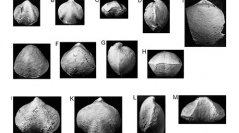

 Geodiversitas
25 (1) - Pages 73-107
Geodiversitas
25 (1) - Pages 73-107Silurian and Lower Devonian sequences of the carbonate sediments of the Severnaya Zemlya Archipelago, and adjacent territories, are rich in fossils, among which brachiopods are dominating. The association of brachiopods includes 25 taxa. Strophomenids, atrypids and spiriferids are the most diverse groups, although the most common are the rhynchonellids. Seven new species are described: Brachyprion ruminatus n. sp., Lenatoechia octjabrensis n. sp., Anabaria? latens n. sp., Undispirifer? obsoletiplicatus n. sp., Grebenella laciniatus n. sp., Hyattidina remota n. sp., and Greenfieldia orbiculata n. sp. Most of the brachiopod communities are characteristic of shallow water environments and represent BA-2, BA-3 or BA-4 benthic associations. They indicate the transition from open shallow-water shelf environments to fore-shoal facies. The brachiopod fauna is often monotaxic and is dominated by endemic species. At the generic level this fauna is 74% cosmopolitan, and 26% regional. This fact testifies the existence of palaeobiogeographic similarities between Severnaya Zemlya and the northern Baltica (Novaya Zemlya, Urals, and Baltic region) in the West, and between Severnaya Zemlya and East Siberia (Tajmyr, Siberian Platform) in the East in Silurian time. The assemblage of Devonian brachiopods from Severnaya Zemlya is most similar to the contemporaneous faunas from North-East Russia, Australia and Canadian Arctic Archipelago.
Brachiopoda, Silurian, Devonian, Severnaya Zemlya, East Siberia, Urals, Timan, Russian Arctic, Canadian Arctic, biostratigraphy, palaeobiogeography, new species